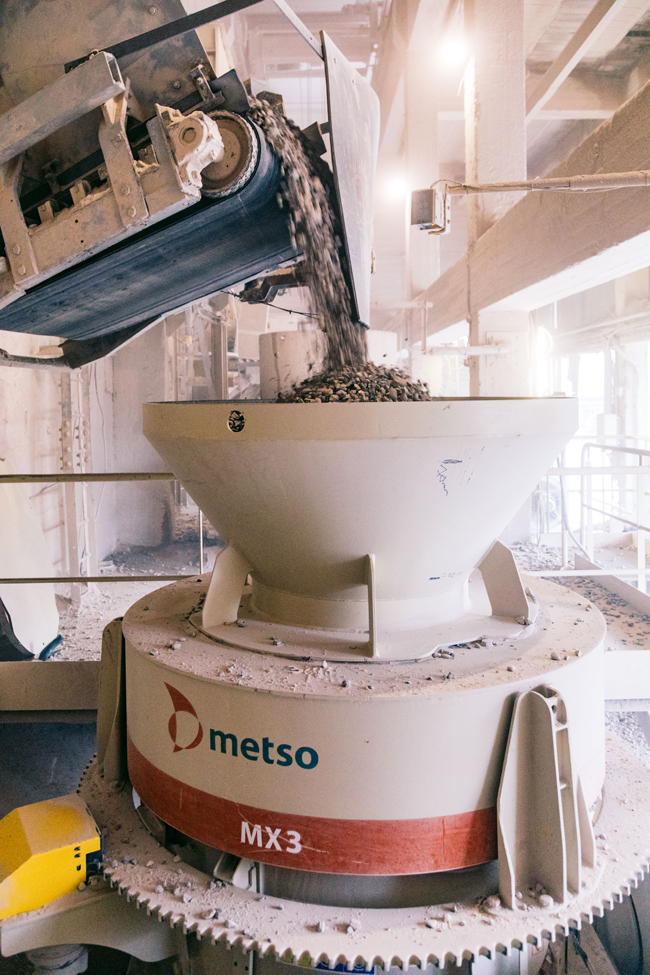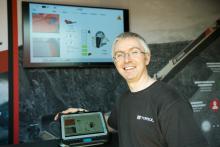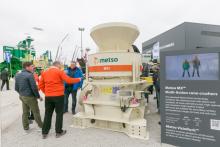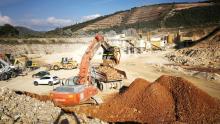
Metso is looking to expand its SiteBooster crushing and screening plant optimisation solution from the existing core market in France to the rest of Europe.
SiteBooster plant optimisation solutions have been applied to aggregates plants since 2005, but are not yet widely used outside of France, apart from a few deployments in Germany, Norway and Morocco.
The SiteBooster team is located at Metso’s French base of Mâcon and the solution involves a three-stage process for optimising the performance of crushing and screening plant at quarries: comprehensive audit, optimised redesign and professional implementation.
The solution has a variety of use cases. These can include a customer that wants to replace an obsolete machine which is acting as a bottleneck for the plant, to change material or end product, to reduce downtime, or to meet new regulations requiring a reduction in energy consumption or improvements to the safety of staff.
“Instead of investing in a new plant, customers can spend much less money to adjust their existing assets, with the minimum of disruption to production,” according to Bruno Peix, VP systems, aggregates equipment business area at Metso.
He adds that Europe is a suitable region to start with for the expansion as Metso has more local resources able to cover this plant optimisation market.
“We have built a dedicated, fully integrated team [at Mâcon] with process experience and people able to do process layout, quotations and project management,” says Peix. “These people are able to audit the site and take measurements of what customers have in the existing quarries. We do the redesign of what could be better for them.
“There are plenty of quarries that want to invest in new plants. If we can show them that they can have better productivity or product quality with their existing assets, with just a small amount of money to replace or add one machine, they will buy it.”
Metso sells between 40 and 60 SiteBooster projects a year of different sizes in France, encompassing anything from one machine through to three or four.
Peix says that productivity can be increased with better automation, which can also help crushing and screening plant operators to reduce electricity consumption.
“If the operator wants to increase the tonnes per hour capacity of their crushing and screening plant, we start with an audit and provide a list of recommendations,” he adds. “It can be new crushers or new parts, a conveyor issue being a bottleneck, automation which is not done properly, or how you feed a crusher. Some customers tell us that average capacity is not good, and then when we visit the site we realise that the crusher runs empty for 30% of the day.”
This under-utilisation of plant can be due to a number of issues, such as poor management of hoppers. When these hoppers fill up to capacity, the upstream conveyors have to stop until the level of the hopper decreases. Conversely, when the hopper is empty too quickly, the crusher downstream has to run empty. All should be well balanced thanks to sensors, automation settings and regulation.
“All this stop and start harms efficiency,” says Peix.
“Once the audit and measurements of the existing site have been done, we deliver everything to the site,” he adds. “The shutdown can be anything from two days to a month, depending on the size of the change. We try to optimise the downtime for the customer for them not to lose too much running time and production.”
An example of a SiteBooster deployment is by
Durance Granulats wanted to improve the aggregates production capacity and crushing power consumption at the quarry and achieved its goals by replacing obsolete machinery with
“At Durance, like in most of the cases, we try to keep as much as we can and only replace what needs to be replaced to limit investments,” he adds.
The main selection criterion for the MX4 was the maximum feed size. The Durance Granulats team worked alongside Metso to develop the latest addition to the MX cone crusher series, the MX3.
“The MX4 has met our expectations and delivered instantaneous flow rate as well as improved crushing energy efficiency of about 12%,” said Mathieu Kasprzak, director of operations at Durance Granulats. “We have also been piloting the MX3 cone crusher on quaternary stage since April 2018 and we are fully satisfied with its performance and plan to continue with it.”
Another deployment of SiteBooster was in a plant relocation project for a quarry operator in France. Metso helped to move an existing plant the operator had in the west of France to a new quarry site that produces hard rock in the north of the country.
“We supplied brand new primary units and relocated all the secondary/tertiary plant they had in western France to the new quarry,” says Peix. “We moved three screens with all related steel structures and conveyors dismantled and reassembled at the new site. There were very few additions to the existing plant. There were some small screens to wash the final product that they didn’t have on the previous site.”
He adds that the biggest benefits that SiteBooster can provide for quarry customers are better quality of final product (shape of aggregate) and better capacity.
The first customer deployment has taken place of the new OMNI by
The tablet-based system has been launched by
The OMNI system is fitted inside the cab of a material feed excavator and provides operators with centralised remote access to multiple machine control systems within a crushing and screening train.
The system is designed to improve jobsite safety and efficiency in the operation of crushing and screening equipment. It features a simple graphic control interface that is designed for ease of use, and live-camera views from critical vantage points. Each crushing and screening machine in the train can be fitted with up to two cameras, from vantage points such as material transition points, chamber inlets, and material choke level on cones.
The excavator operator can view information from each machine that is connected to the system, make informed decisions about the machine’s operation, and remotely manage the entire machine train with global functions.
The operator can adjust individual machine metrics or use global features, such as pausing the entire material flow across the train with one action, which Powerscreen says allows unprecedented levels of control from the comfort and safety of the excavator cab.
OMNI also provides alerts that indicate when someone on the ground is making process adjustments.
“We have tested OMNI on up to six mobile crushing and screening units in a train,” says Michael McGlinchey, Terex MP Group Electrical Systems Manager, who leads the OMNI project. “The main advantage is health and safety – everything is centrally controlled.”
By enabling multiple linked plant to be controlled from within the cab, it removes the need for operators to leave the cab and manually intervene when they occur.
“There are a lot of blindspots [for operators] in the junctions from one machine to another, such as the transfer of material from the conveyor to the feeder of the first crusher,” McGlinchey adds.
The primary tablet used in the system is a heavy-duty device equipped with a dust screen. The tablet is read/write enabled and is usually used by the excavator operator, who is the person with overall control of the system. One button on the primary tablet can immediately stop all the feeders if a problem is detected or material flow needs to be interrupted.
OMNI also features the facility for a secondary read-only tablet that can be operated by a wheeled loader driver or supervisor to monitor the machines.
On the fleet status page for all machines in the train, the tablet displays the serial number of each machine. This can be changed by the primary tablet operator to any name they choose. The fleet status page also features the fuel level, engine RPM, engine load and hydraulic oil temperature of each machine, amongst other information.
Further data can be accessed by clicking on the icon of a particular machine, including the two camera views. The machine settings for crushing and screening can also be changed to tune the machine to the application and manage the effect of material variability.
If the alarm on a particular machine is activated, the machine’s icon on the fleet status page starts to flash.
Whitewall Quarry near Malton in North Yorkshire is the first customer to deploy the OMNI system, which is being used to control a newly-purchased
Kevin Calvert, quarry manager at Whitewall Quarry said, “We have been testing Powerscreen’s OMNI system and we’re impressed at how we’re able to view working information from live cameras as well as the level of control we have—all from the comfort and safety of the excavator cab.”
The OMNI system is also currently being tested by prospective customers in Scotland, the Republic of Ireland and at another quarry in Yorkshire.
The Scottish site is using OMNI to control a train with a cone and a jaw crusher. “With cone crushers the chamber can often get clogged, requiring the operator to get out of the machine,” says McGlinchey. “Now they can handle the problem by making adjustments while staying in the cab.”
OMNI is now being offered as an option on all Powerscreen crushing and screening machines.
E-Mak’s latest invention is an aggregate factory which takes rock from a quarry, crushes it, sorts the aggregates into sizes and delivers them in the proportions required. Called Megaton, it can be used for aggregate production, concrete production and cold mix production.
Megaton has been designed to operate in major materials production facilities, close to large conurbations. It can be built to serve all or any combination of the applications mentioned above.
“The inspiration actually came from Istanbul, where there is a huge quarry, used by multiple construction companies, which is now surrounded by houses due to the increasing population of the city. In situations like that Megaton would be ideal,” said Onur Recepgil, brand and marketing manager for E-Mak.
As well as limiting dust, Megaton prevents aggregates from taking on moisture, reducing the energy needed for asphalt production. Due to the controlled environment in which the aggregates are stored, it can also lead to higher-quality materials, according to E-Mak.
The first version of the Megaton will be erected at a quarry and materials production facility in Bursa, Turkey, which is owned by E-Mak sister company Singemat, having made a show-stopping appearance at
The Megaton process sees pieces of rock from a quarry fed through a vertical shaft impactor (VSI) crusher with a capacity of 450 tonnes per hour. The aggregate is then lifted by a vertical elevator into the sieving units to grade the aggregate which is then stored according to its size within the 3,000 tonne-capacity silo. The right combination of aggregate grades can then be delivered directly to an aggregate or concrete plant.
“At the quarry in Bursa we will have two sieving units, one to serve the concrete production and the other for the asphalt production because they require different gradings,” explained E-Mak international sales manager Muhammed Elhatip.
As well as the benefits to the air quality and energy savings due to having dry aggregates, the Megaton could also make production more efficient, said Elhatip. “The machine could run all night, for example, so that you have 3,000 tonnes of clean aggregate ready for production in the morning.”







